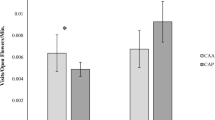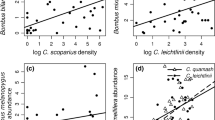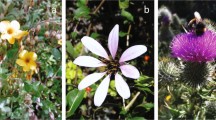Abstract
Alien invasive plant species can affect pollination, reproductive success and population dynamics of co-flowering native species via shared pollinators. Consequences may range from reproductive competition to facilitation, but the ecological drivers determining the type and magnitude of such indirect interactions remain poorly understood. Here, we examine the role of the spatial scale of invader presence and spatially contingent behavioural responses of different pollinator groups as potential key drivers, using the invasive Oxalis pes-caprae and the self-incompatible native annual Diplotaxis erucoides as a model system. Three treatments were assigned to native focal plants: (1) invader present at the landscape scale (hectares) but experimentally removed at the floral neighbourhood scale (pa); (2) invader present at both scales (pp); (3) invader absent at both scales (aa). Interestingly, we found pronounced spatially contingent differences in the responses of pollinators: honeybees and bumblebees were strongly attracted into invaded sites at the landscape scale, translating into native plant visitation facilitation through honeybees, while bumblebees almost exclusively visited Oxalis. Non-corbiculate wild bees, in contrast, showed less pronounced responses in foraging behavior, primarily at the floral neighborhood scale. Average heterospecific (Oxalis) pollen deposition onto stigmas of Diplotaxis was low (<1 %), but higher in the pp than in the pa treatment. Hand-pollination of Diplotaxis with Oxalis and conspecific pollen, however, reduced seed set by more than half when compared to hand-pollination with only conspecific pollen. Seed set of Diplotaxis, finally, was increased by 14 % (reproductive facilitation) in the pp treatment, while it was reduced by 27 % (reproductive competition) in the pa treatment compared to uninvaded populations. Our study highlights the crucial role of spatial scale and pollinator guild driving indirect effects of invasive on co-flowering native plant species.





Similar content being viewed by others
References
Albrecht M, Duelli P, Müller C, Kleijn D, Schmid B (2007) The Swiss agri-environment scheme enhances pollinator diversity and plant reproductive success in nearby intensively managed farmland. J Appl Ecol 44:813–822
Albrecht M, Padrón B, Bartomeus I, Traveset A (2014) Consequences of plant invasions on compartmentalization and species’ roles in plant–pollinator networks. Proc R Soc B 281:20140773. doi:10.1098/rspb.2014.0773
Bartomeus I, Bosch J, Vilà M (2008) High invasive pollen transfer, yet low deposition on native stigmas in a Carpobrotus-invaded community. Ann Bot 102:417–424
Bjerknes AL, Totland Ø, Hegland SJ, Nielsen A (2007) Do alien plant invasions really affect pollination success in native plant species? Biol Conserv 138:1–12
Brown BJ, Mitchell RJ (2001) Competition for pollination: effects of pollen of an invasive plant on seed set of a native congener. Oecologia 129:43–49
Brown BJ, Mitchell RJ, Graham SA (2002) Competition for pollination between an invasive species (purple loosestrife) and a native congener. Ecology 83:2328–2336
Campbell DR, Motten AF (1985) The mechanism of competition for pollination between two forest herbs. Ecology 66:554–563
Cariveau DP, Norton AP (2009) Spatially contingent interactions between an exotic and native plant mediated through flower visitors. Oikos 118:107–114
Chittka L, Schürkens S (2001) Successful invasion of a floral market. Nature 411:653
Costa J, Ferrero V, Castro M, Jorge A, Afonso A, Loureiro J, Castro S (2014) Pollen flow between flowers of the same morph in invasive populations of Oxalis pes-caprae L. in the western Mediterranean region. Plant Biosyst. doi:10.1080/11263504.2014.991363
Feinsinger P (1987) Effects of plant species on each other’s pollination: is community structure influenced? Trends Ecol Evol 2(5):123–126
Feldman TS, Morris WF, Wilson WG (2004) When can two plant species facilitate each other’s pollination? Oikos 105(1):197–207
Ferrero V, Castro S, Costa J, Acuña P, Navarro L, Loureiro J (2013) Effect of invader removal: pollinators stay but some native plants miss their new friend. Biol Invasions 15:2347–2358
Flanagan RJ, Mitchell RJ, Karron JD (2010) Increased relative abundance of an invasive competitor for pollination Lythrum salicaria reduces seed number in Mimulus ringens. Oecologia 164:445–454
Flanagan RJ, Mitchell RJ, Karron JD (2011) Effects of multiple competitors for pollination on bumblebee foraging patterns and Mimulus ringens reproductive success. Oikos 120:200–207
Ghazoul J (2006) Floral diversity and the facilitation of pollination. J Ecol 94:295–304
Goulson D (1999) Foraging strategies of insects for gathering nectar and pollen and implications for plant ecology and evolution. Perspect Plant Ecol Evol Syst 2:185–209
Gulyás S, Czimber G (1990) Apicultural importance of Diplotaxis erucoides (Torner) DC. Acta Ovar 32(1):12–17
Jakobsson A, Padrón B (2014) Does the invasive Lupinus polyphyllus increase pollinator visitation to a native herb through effects on pollinator population sizes? Oecologia 174:217–226
Jakobsson A, Padrón B, Traveset A (2008) Pollen transfer from invasive Carpobrotus spp to natives—a study of pollinator behaviour and reproduction success. Biol Conserv 141:136–145
Jakobsson A, Padrón B, Traveset A (2009) Competition for pollinators between invasive and native plants: effects of spatial scale of investigation. Ecoscience 16:138–141
Jha S, Vandermeer JH (2009) Contrasting bee foraging in response to resource scale and local habitat management. Oikos 118:1174–1180
Kanchan S, Chandra J (1980) Pollen allelopathy—a new phenomenon. New Phytol 84:739–746
Kandori I, Hirao T, Matsunaga S, Kurosaki T (2009) An invasive dandelion unilaterally reduces the reproduction of a native congener through competition for pollination. Oecologia 159:559–569
Kearns CA, Inouye DW (1993) Techniques for pollination biologists. University Press of Colorado, Colorado
Klinkhamer PG, De Jong TJ, Linnebank LA (2001) Small-scale spatial patterns determine ecological relationships: an experimental example using nectar production rates. Ecol Lett 4:559–567
Kunin WE (1992) Density and reproductive success in wild populations of Diplotaxis erucoides (Brassicaceae). Oecologia 91:129–133
Kwak MM, Jennersten O (1991) Bumblebee visitation and seed set in Melampyrum pratense and Viscaria vulgaris: heterospecific pollen and pollen limitation. Oecologia 86:99–104
Lopezaraiza-Mikel ME, Hayes RB, Whalley MR, Memmott J (2007) The impact of an alien plant on a native plant–pollinator network: an experimental approach. Ecol Lett 10:539–550
Mitchell RJ, Flanagan RJ, Brown BJ, Waser NM, Karron JD (2009) New frontiers in competition for pollination. Ann Bot 103:1403–1413
Moeller DA (2004) Facilitative interactions among plants via shared pollinators. Ecology 85:3289–3301
Molina-Montenegro MA, Badano EI, Cavieres LA (2008) Positive interactions among plant species for pollinator service: assessing the ‘magnet species’ concept with invasive species. Oikos 117:1833–1839
Moragues E, Traveset A (2005) Effect of Carpobrotus spp on the pollination success of native plant species of the Balearic Islands. Biol Conserv 122:611–619
Morales CL, Traveset A (2009) A meta-analysis of impacts of alien vs native plants on pollinator visitation and reproductive success of co-flowering native plants. Ecol Lett 12:716–728
Moran MD (2003) Arguments for rejecting the sequential Bonferroni in ecological studies. Oikos 100:403–405
Muñoz AA, Cavieres LA (2008) The presence of a showy invasive plant disrupts pollinator service and reproductive output in native alpine species only at high densities. J Ecol 96:459–467
Nielsen C, Heimes C, Kollmann J (2008) Little evidence for negative effects of an invasive alien plant on pollinator services. Biol Invasions 10:1353–1363
Padrón B, Traveset A, Biedenweg T, Díaz D, Nogales M, Olesen JM (2009) Impact of alien plant invaders on pollination networks in two archipelagos. PLoS ONE 4:e6275. doi:10.1371/journal.pone.0006275
Peirce JR (1997) The biology of Australian weeds: 31 Oxalis pes-caprae L. Plant Protect Q 12:110–119
Pinheiro J, Bates D, DebRoy S, Sarkar D, R Core Team (2009) nlme: linear and nonlinear mixed effects models. R package version, 31–96
R Development Core Team (2013) R: a language and environment for statistical computing. R Foundation for Statistical Computing, Vienna
Rathcke BJ (1983) Competition and facilitation among plants for pollination. In: Real L (ed) Pollination biology. Academic, New York, pp 305–329
Sans XF, Bonet A (1993) Producción de frutos y semillas en Diplotaxis erucoides (L.) DC sometida a diferentes tratamientos de polinización. Collect Bot 22:49–54
Sargent RD, Ackerly DD (2008) Plant–pollinator interactions and the assembly of plant communities. Trends Ecol Evol 23:123–130
Schemske DW (1981) Floral convergence and pollinator sharing in two bee-pollinated tropical herbs. Ecology 62:946–954
Sih A, Baltus MS (1987) Patch size, pollinator behavior and pollinator limitation in catnip. Ecology 68:1679–1690
Steffan-Dewenter I, Münzenberg U, Bürger C, Thies C, Tscharntke T (2002) Scale-dependent effects of landscape context on three pollinator guilds. Ecology 83:1421–1432
Sun SG, Montgomery BR, Li B (2013) Contrasting effects of plant invasion on pollination of two native species with similar morphologies. Biol Invasions 15:2165–2177
Thomson JD (1978) Effects of stand composition on insect visitation in two-species mixtures of Hieracium. Am Midl Nat 100:431–440
Totland Ø, Nielsen A, Bjerknes AL, Ohlson M (2006) Effects of an exotic plant and habitat disturbance on pollinator visitation and reproduction in a boreal forest herb. Am J Bot 93:868–873
Traveset A, Heleno R, Chamorro S, Vargas P, McMullen CK, Castro-Urgal R, Nogales M, Herrera HW, Olesen JM (2013) Invaders of pollination networks in the Galápagos Islands: emergence of novel communities. Proc R Soc B 280:20123040. doi:10.1098/rspb.2012.3040
Trigo MM, Melgar M, García J, Recio M, Docampo S, Cabezudo B (2007) El polen de la atmósfera de Vélez-Málaga. Concejalía de Medio Ambiente Ayuntamiento de Vélez, Málaga
Vila M, Bartomeus I, Gimeno I, Traveset A, Moragues E (2006) Demography of the invasive geophyte Oxalis pes-caprae across a Mediterranean island. Ann Bot 97:1055–1062
Warton DI, Hui FK (2011) The arcsine is asinine: the analysis of proportions in ecology. Ecology 92:3–10
Waser NM, Fugate ML (1986) Pollen precedence and stigma closure: a mechanism of competition for pollination between Delphinium nelsonii and Ipomopsis aggregata. Oecologia 70:573–577
Waser NM, Real LA (1979) Effective mutualism between sequentially flowering plant species. Nature 281:670–672
Westphal C, Steffan-Dewenter I, Tscharntke T (2003) Mass flowering crops enhance pollinator densities at a landscape scale. Ecol Lett 6:961–965
Westphal C, Bommarco R, Carré G, Lamborn E, Morison N, Petanidou T, Potts SG, Roberts SPM, Szentgyörgyi H, Tscheulin T, Vaissière BE, Woyciechowski M, Biesmeijer JC, Kunin WE, Settele J, Steffan-Dewenter I (2008) Measuring bee diversity in different European habitats and biogeographical regions. Ecol Monogr 78:653–671
Zuur A, Ieno EN, Walker N, Saveliev AA, Smith GM (2009) Mixed effects models and extensions in ecology with R. Springer, New York
Acknowledgments
We thank Cristina Tur, Veriozka Azenas, Clara Vignolo, Rocío Castro and Xavi Rotllán, for their help in the field and the laboratory. Moreover, we thank María del Mar Trigo Pérez for valuable help with pollen identification and Charles Novaes for statistical advice. We are also grateful to two anonymous referees for valuable comments on earlier versions of the manuscript. This work was supported by a fellowship for prospective researchers by the Swiss National Science Foundation (Grant No. PBZHP3-131020).
Author information
Authors and Affiliations
Corresponding author
Electronic supplementary material
Below is the link to the electronic supplementary material.
Rights and permissions
About this article
Cite this article
Albrecht, M., Ramis, M.R. & Traveset, A. Pollinator-mediated impacts of alien invasive plants on the pollination of native plants: the role of spatial scale and distinct behaviour among pollinator guilds. Biol Invasions 18, 1801–1812 (2016). https://doi.org/10.1007/s10530-016-1121-6
Received:
Accepted:
Published:
Issue Date:
DOI: https://doi.org/10.1007/s10530-016-1121-6




